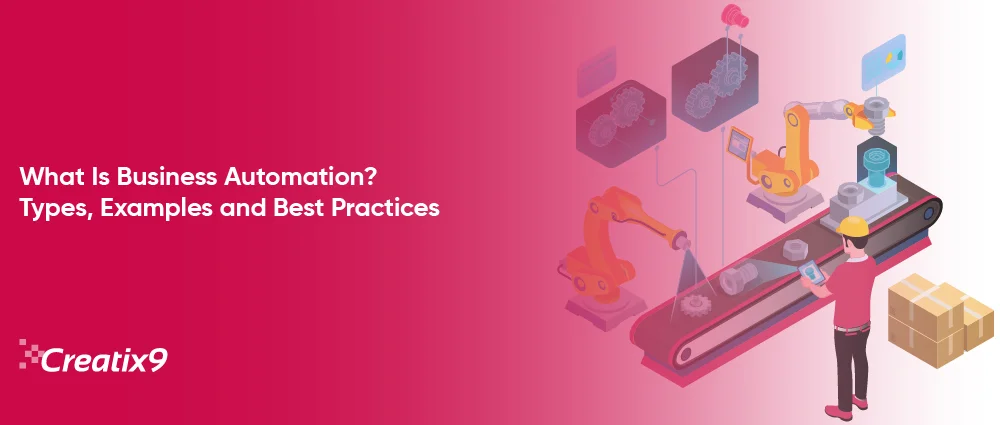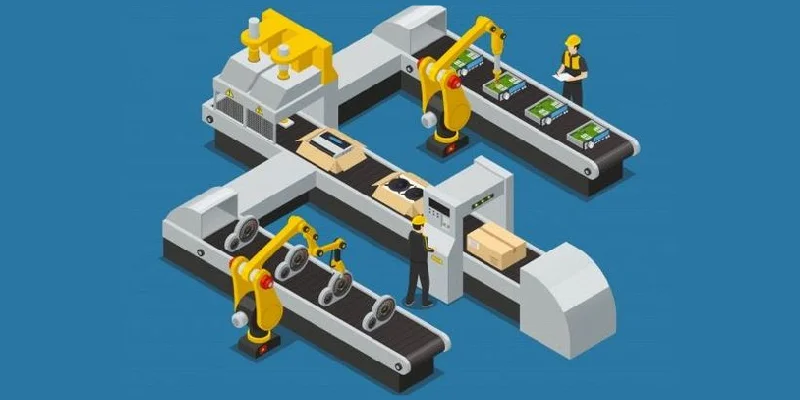
Although business automation might appear new, it has a history spanning over half a century. An early instance occurred in 1967 when Barclays Bank introduced the world’s inaugural Automated Teller Machine (ATM) in London, updating the banking field.
AI-driven automation tools endow businesses to fully mechanize intricate processes, like customer satisfaction, market data analysis, employee onboarding, vendor management, and relationship management.
The pursuit of finely tuned efficiency in business operations compels that managers, employees, and stakeholders remain well-informed about advancements in business automation. Utilizing the latest technological innovations is vital for survival in fiercely competitive markets.
Moreover, automation can handle time-consuming and labor-intensive tasks that burden available resources substantially.
Automating fundamental organizational and managerial processes enables the redirection of creative energies toward expanding one’s business. Opting for business automation services is now a trendy way for most businesses to execute automation.
Here we will talk about:
- What do you mean by business automation?
- Varieties of business automation
- Instances of business automation
- Advantages and obstacles associated with business automation
- Optimal approaches for implementing business automation
What is business automation?
 Business process automation is the use of technology (workflow automation software, AI/ML data integration and APIs etc.) to automate business processes. You can simplify operations, achieve digital makeover, enhance service quality, optimize service delivery, and manage costs well.
Business process automation is the use of technology (workflow automation software, AI/ML data integration and APIs etc.) to automate business processes. You can simplify operations, achieve digital makeover, enhance service quality, optimize service delivery, and manage costs well.
BPA is all about the integration of applications, the reorganization of workforce resources, and the widespread use of software applications throughout an organization. Robotic process automation is an emerging subfield within BPA.
Let’s take an example, a SME is in intention make an ad campaign for a new brand. Target customers can find out what they like by using Google Analytics. This data can then be used by the marketing team in making ads for customers.
For instance, the marketing team collaborates with Google Analytics to plot the ad campaign. Improve your business and be faster and cheaper.
Manual purchase order process
Manual purchase order processing presents significant challenges: arduous, inefficient, and time-consuming. It is also prone to some mistakes that could be expensive. In this case, the whole order processing in the manual workflow is based on many people’s participation.
- Purchase orders received by an employee:The employee inputs the customer data into sales records and verifies receipt of an order from the customer.
- Payment Processing:The payment method, the signatures needed, and the terms and conditions are checked and sent to the customer. Discounts and promo codes are entered.
- Order fulfillment:The communication between inventory management and SKU generation allows for order picking and packaging in a correct manner.
- Shipping and delivery: Ordering the suitable delivery carrier, verifying delivery data, and notifying the customer regarding the expected delivery timing.
- Customer experience follow-up:This includes keeping track of the sale orders shipped within the stipulated time, dealing with any return or refund issues arising from the product, and ensuring that the customers are satisfied with the product.
- Measure and analyze the process: Each step of data entry for future analysis; discussing process issues with relevant parties or management and manual data analysis to develop process improvement in the long run.
Automated purchase order process
Automating purchase order processing makes this process easier with little or no assistance from employees, resulting in a reduction of time, reduction of costs, and error minimization.
- Purchase orders received by an automation tool: Customer data is automatically fed into sales records, and confirmation of sale is sent to the customer via email.
- Payment Processing: Validation of payment methods, signing off terms & conditions to customers, tracking discounts or vouchers.
- Order fulfillment: Informing the order inventory management and creating the correct SKU for picking and packaging.
- Shipping and delivery: Confirming the selection of the right carrier, checking delivery information, and sending a notification letter to a client for anticipated delivery.
- Customer experience follow-up: Order tracking through order date, including return policy, a customer-return or refund request form, and a final stage of a customer satisfaction survey to verify the quality of the product delivered.
- Measure and analyze the process: Data collection at each step; overview of process issues reporting to relevant parties or management; insight generation through automated data analysis.
Business automation Types
 Three primary categories of business automation are distinguished by the complexity of the processes involved and the tools employed.
Three primary categories of business automation are distinguished by the complexity of the processes involved and the tools employed.
Each type of automation serves specific business functions. For example, robotic automation is commonly utilized in production and manufacturing. In contrast, AI automation is crucial in data analysis and risk management.
Business process automation
BPA refers to using software technology to simplify complex business procedures. You can improve the efficiency and transparency of these processes with insightful information through data.
Major one is a digital instrument such as Customer Relationship Management (CRM) software. The first process of the system is to collect, store, and evaluate all sales leads generated inside the organization. Employees can access all this data in a consolidated form on one platform.
With the aid of CRMs, the sales team also can send follow-up emails and regularly communicate with all customers, and partners— automating key sales processes, including lead capture and client engagement.
Another is a Workflow Management System (WMS), a powerful tool to streamline and optimize the workflow of an organization’s tasks, processes, and information. Workflow is simple to manage and automate. They assign tasks and complete and monitor them without any hiccups. Using a WMS gives you high productivity at low error levels and insights into your operations.
Robotic process automation
 RPA is a software-based approach that replaces manual repetitive tasks. They can handle large-scale back-office tasks such as information extraction, file movement, and form filling for industries. This automation performs the same routine hundreds of thousands of times.
RPA is a software-based approach that replaces manual repetitive tasks. They can handle large-scale back-office tasks such as information extraction, file movement, and form filling for industries. This automation performs the same routine hundreds of thousands of times.
Web scraping is an instance of RPA where bots simultaneously use robotic programs to collect data from numerous websites. The data is then filtered out and scrutinized, which leads to the discovery of crucial insights applicable to the world.
For example, e-commerce websites are another instance of RPA that uses order processing software. All the order-related data; this automation software gathers and arranges on an e-retail platform. With this, firms can speed up packing and shipping; it lowers manual procedures like data entry and processing.
Artificial intelligence (AI)
 Prominent among them is Artificial Intelligence (AI— an advanced mode of business automation. Here software tools analyze large data sets; knowledge then used by AI automation tools to react to new conditions.
Prominent among them is Artificial Intelligence (AI— an advanced mode of business automation. Here software tools analyze large data sets; knowledge then used by AI automation tools to react to new conditions.
Machine Learning (ML) is a process through which they learn the fundamental rules of a process by analyzing millions of instances. After integration, one can use these rules in new cases to produce decisions automatically.
One excellent example of AI-based automation is data visualization and analysis software such as Microsoft’s Power BI. This tool is designed to interrogate large amounts of business data for detecting trends from which meaningful business insights are derived.
Another example of AI-driven automation is using NLP-enabled writing bots and chatbots for customer service. For instance, NLP tools are highly trained in language literature to learn about sentence structure, grammar, syntax, and the unique diction of different languages.
Business automation examples
 Business Automation Tool in Concrete Instances for Better Understanding.
Business Automation Tool in Concrete Instances for Better Understanding.
Customer Relationship Management (CRM) automation
In this regard, a large volume of sales lead data is handled by CRM processes, which makes it necessary to have a standard way of capturing, filtering, organizing, and making it accessible to all the necessary company staff.
The above discussion indicates that CRM automation tools facilitate operations; workers can develop viable business relationships with clients. Here’s how a typical automated CRM tool handles various tasks:
Lead capture: All company emails and web forms are actively scanned by the software to uncover essential lead details like name, age, gender, and location. Automated data filtering fills missing lead information by default and removes irregular or unsuitable data.
Data organization: The filtered lead data is automatically organized into manageable segments by the software based on defined parameters such as age, gender, and location, leading to more manageable relevant lead identification.
User access control: Roles can automatically assign data access to an employee.
Social media automation
Social media automation applications help marketers schedule and automate some critical tasks related to social media engagement. The specific tasks cover scheduling of posts, audience engagement analysis, and creation of automatic responses to the queries.
Additionally, these automation platforms can send specific tweets or posts on LinkedIn, which is when most people are active. Such bots can also be designed to repost top content for better audience engagement.
Automation of bookkeeping and accounting
Automating accounting and bookkeeping involves utilizing tools that assist in automating various bookkeeping activities, including producing bills and verifying bills, processing payments, managing tax filings, and generating balance sheets for bookkeeping teams.
Accountants can complete these documents much faster and dispatch them because such tools come with all required tax forms and vendor invoice templates.
Advantages and obstacles associated with business automation
By understanding the benefits and challenges of business automation, you will know what to expect regarding such processes and what pitfalls to watch out for.
Benefits
Here are some critical advantages of utilizing business automation tools:
- Enhanced efficiency: Routine tasks can be automated, leading to faster execution of large-scale business operations, bringing maximum efficiency. Workflow streamlining is achieved by using these tools with minimal human control.
- Cost reduction: Automating business processes also saves costs by cutting down time and labor requirements and eliminating human mistakes.
- Augmented productivity: With workflow automation, businesses become powerful enterprises capable of using labor and other resources more efficiently.
- Enhanced data accuracy: Smarter automation solutions are better at gathering and processing business data than human beings. Automation is particularly helpful in managing large amounts of business data.
- Informed decision-making: For instance, it can assist businesses in designing appropriate marketing plans. This allows them to adopt market trends into their strategies and appraise the marketing campaign before implementation via clever consumer profiles.
Challenges
However, there are specific challenges associated with employing business automation tools:
- Implementation costs: Most business automation tools require initial startup costs and a renewal subscription fee.
- Demand for skilled personnel: Adopting new automation tools often necessitates significant time and energy to train and onboard employees effectively.
- Resistance to change: Most automation processes call for employee adoption, which may trigger workforce resistance as the employees struggle with the necessary efforts.
- Security concerns: Modernizing business automation is characterized by data collection, which enhances efficiency and makes data-driven decision-making possible while increasing the risk of data breaches or malicious attacks.
Optimal approaches for implementing business automation
Here, we present several industry-recommended practices to assist you in implementing automation within your business:
- Begin modestly: Begin the automation process in straightforward clerical functions like data collection and organization before moving on to the whole workflow of a business. This allows for the smooth integration of your integrated components.
- Identify suitable processes: It will entail prioritizing identifying specific processes that need to be automated based on their importance. Start with repetitive tasks, taking up a lot of time and effort as they are promising areas of focus.
- Select appropriate tools: Conduct comprehensive market research to determine the automation tools that match your demand. Make informed decisions for your business regarding selecting the right automation tools, such as features, pricing, and scalability.
- Plan for scalability: For any solution being considered for transitioning between automation tools, it must be a versatile one that can adapt and grow with the company.
- Provide staff training: Set up dedicated onboarding processes for your existing and new hires on how to use automation tools. They learn how to use this tool effectively.
Createix9 for automation in the United States.
Business automation is highly effective. Next, the more advances that will be made in automating technologies, a large-scale business revamping can occur – even more than before automation over the coming ten years.
Digital innovation has become continuous, giving small businesses easy access to automation tools with reduced costs.
Suppose you are a business owner considering the implementation of business process automation. In that case, you can take our business automation services in the US.
You can choose from a diverse pool of business automation developers from Creatix9—the prominent software development company in the US.
Visit our creative digital agency website and subscribe now.

